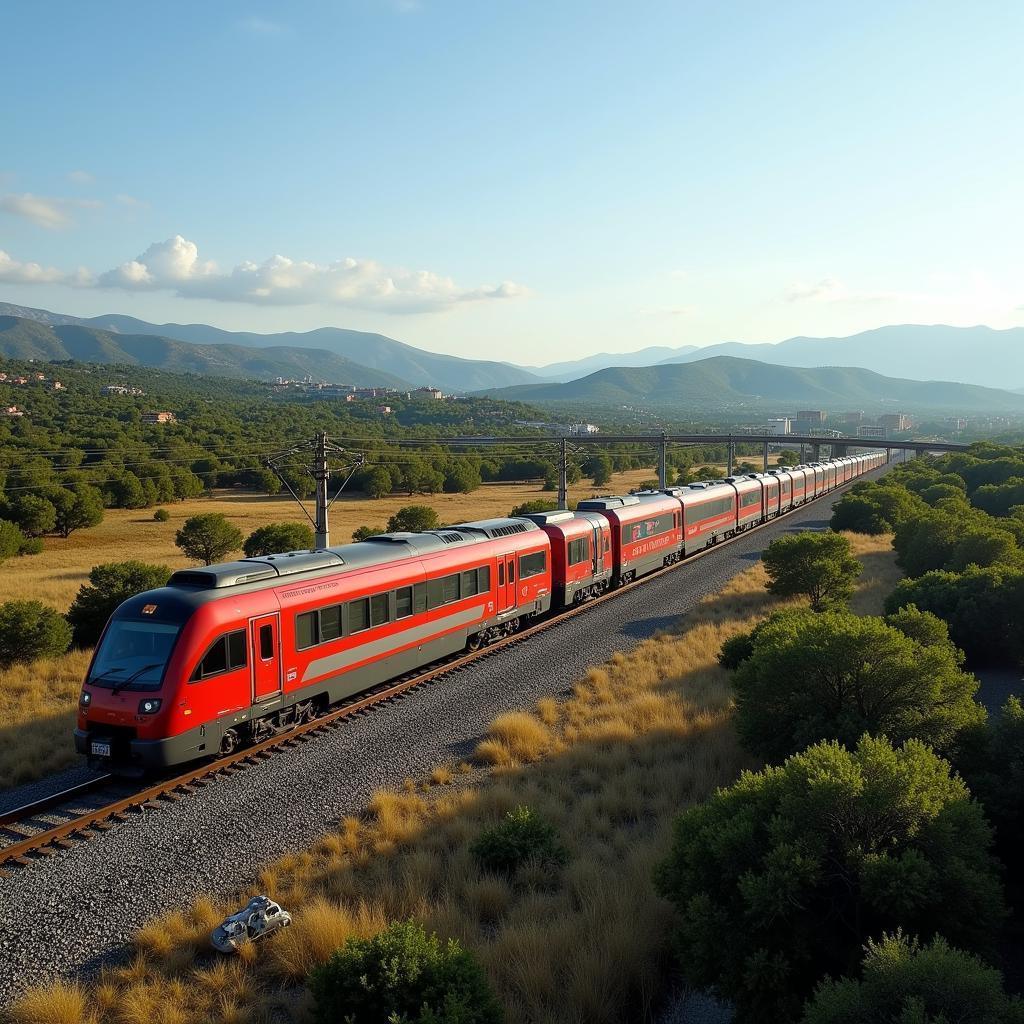Container train transport between Madrid and Barcelona provides a dependable and efficient solution for businesses seeking sustainable and cost-effective cargo shipping. This guide explores the advantages, processes, and key considerations for utilizing this essential rail connection.
Understanding the Benefits of Rail Freight
Rail freight between Madrid and Barcelona offers several significant advantages over traditional road transport. Its environmentally friendly nature drastically reduces carbon emissions, aligning with sustainability objectives. Predictable transit times and less congestion on rail lines offer greater reliability compared to road transport, which is often prone to unexpected traffic delays. Furthermore, rail transport provides enhanced security for goods, minimizing the risk of theft or damage. Cost-effectiveness is another key benefit, especially for large volume shipments.
- Reduced carbon footprint
- Reliable transit times
- Enhanced security
- Cost-effective for bulk shipments
Navigating the Container Train Process: Madrid to Barcelona
The process of shipping via container train from Madrid to Barcelona is streamlined and transparent. It begins with selecting an appropriate container size and type based on the specific cargo needs. Next, businesses arrange for cargo consolidation and loading at the Madrid rail terminal. Once loaded, the train departs on a scheduled route to Barcelona. Upon arrival, containers are unloaded and ready for collection or onward distribution.
- Choose the appropriate container
- Consolidate and load cargo in Madrid
- Transport via rail to Barcelona
- Unload and collect cargo upon arrival
Key Considerations for Container Train Transport
Several crucial factors should be considered when opting for container train transport between Madrid and Barcelona. Accurate documentation is essential for smooth customs clearance and processing. Understanding the specific regulations for different cargo types is crucial for compliance. Choosing a reputable logistics provider experienced in rail freight management is also vital for seamless transportation. Finally, businesses should factor in transit time and schedule shipments accordingly to optimize supply chain efficiency.
- Ensure proper documentation
- Comply with cargo regulations
- Select a reliable logistics provider
- Plan for transit time and schedules
Cost Analysis: Container Train vs. Road Transport
While rail transport generally offers cost advantages for bulk shipments, a detailed cost analysis comparing rail and road transport is crucial. This analysis should include factors like fuel costs, tolls, handling fees, and potential delays. For certain cargo types or smaller shipments, road transport might offer a more economical solution. Therefore, a thorough assessment of individual needs and cost factors is essential.
Choosing the Right Transport Mode for Your Business
The optimal choice between container train and road transport depends on various factors, including cargo type, volume, budget, and time constraints. For businesses prioritizing sustainability and cost-effectiveness for large shipments, container trains offer a compelling solution. However, for smaller, time-sensitive shipments, road transport might be more suitable.
Maximizing Efficiency with Container Train Transport
To maximize the efficiency of container train transport, businesses should leverage technology and data analysis. Real-time tracking systems provide visibility into shipment progress and enable proactive management. Data analytics can help optimize routes, schedules, and resource allocation, leading to greater cost savings and improved supply chain performance. Integrating container train transport into a comprehensive logistics strategy can further enhance overall operational efficiency.
- Utilize real-time tracking systems
- Leverage data analytics for optimization
- Integrate into a comprehensive logistics strategy
Conclusion
Container train transport between Madrid and Barcelona presents a valuable alternative to traditional road transport. By understanding the benefits, processes, and key considerations, businesses can leverage this efficient and sustainable solution to optimize their supply chains and achieve significant cost savings. Choosing the right transport mode requires careful analysis and planning. With proper execution, container train transport can be a game-changer for businesses seeking a reliable and eco-friendly cargo movement solution between these two major Spanish cities.
FAQ
- What is the average transit time for a container train from Madrid to Barcelona?
- What types of containers are compatible with the rail network?
- How secure is container train transport compared to road transport?
- What are the customs regulations for shipping goods between Madrid and Barcelona?
- What are the typical costs associated with container train transport?
- How can I track my shipment during transit? 7.. What are the benefits of using a logistics provider for container train transport?
Common Scenarios and Questions
- Scenario: A manufacturer needs to transport large quantities of raw materials from Madrid to their factory in Barcelona. Question: How can container train transport benefit them in terms of cost and sustainability?
- Scenario: A retailer needs to ship time-sensitive goods from Madrid to Barcelona. Question: Should they choose container train or road transport considering the time constraints?
Further Resources and Information
For more detailed information, explore our other blog posts on rail freight transport, logistics optimization, and sustainable supply chain practices. You can also find helpful resources on the websites of major rail operators and logistics providers.
Contact Us
When you need assistance with your Madrid to Barcelona cargo transport, please contact us at Phone Number: 0372999996, Email: [email protected] or visit our office at 236 Cau Giay, Hanoi. We have a 24/7 customer support team ready to assist you.
